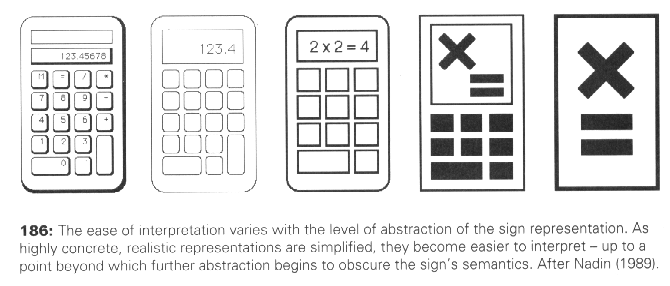
(material from: Designing Visual Interfaces by Mullet and Sano)
Images are particularly important in three areas:
identification
expression
communication
a sign is 'something that stands for someone or something in some respect or capacity'
product of a 3-way relation between the representation, the object, and its mental interpretant
3 levels
representation depends on establishing a clear relationship between a representation and its object


Principles:
Common Errors:
- misleading syntax

what do these represent?
answer: takeoffs and landings (plane viewed from the top, arrow viewed from the side)
- poorly integrated structure

if you need to think about the image and especially if you have to break the image into pieces to understand it, then it doesnt work
a what does this mean?
b,c images that differ in just the direction of an arrow are hard to parse
d small details are hard to parse
- dominant secondary elements

While its good to have a certain amount of regularity, those regular elements should not be the focus of the images
- using type as image

- using images for abstract concepts

hard to find appropriate images for abstract concepts
a - here is where baloon help is really useful to try and put some text on the screen to ID these icons
b - boomerang for 'no-on'?
c - does the stairway suggest sort ascending and sort descending
d - step through a macro?
- images based on obscure allusions

a - master task list (stove icon, things you want to do someday but arent schedued for a particular day - on the back burner)
b - magnet movies an entry from one page to another in an appointment book, axe tool breaks links established by the anchor tool, footprints are backtrack
c
- culture or langauge dependencies

a- defaults, screen dump, C-shell, hello world
b - DOS icon is an image of the original IBM PC - remember those
c - debugger
d - (apple for the teacher?)
e - spelling
f - back burner
g - drag on
- offensive or suggestive imagery

a - kill icon from next-step
b - overly intrusive
c - overly suggestive ???????
d - gestures are culturally based, gun for killing taksks
e - lots of connotations here
f - diembodied limbs - taboo in some cultures
g- more dead tasks
Techniques:
Selection
Refinement
Coordination
(material from: Information Anxiety by Saul Wurman, The Psychology of Human-Computer Interaction by Stuart Card and friends, Designing the User Interface 3rd Ed. by Ben Schneiderman, Human-Computer Interaction 2nd by Dix etc)
3 goals:
assess the extent of the system's functionality
assess the effect of the interface on the user
identify any specific problems with the system
Jonas Salk spent 98% of his time documenting things that didnt work before he found the thing that did
Kenneth Boulding "The moral of evolution is that nothing fails like success because successful adaption leads to the loss of adaptability ... This is why a purely technical evaluation can be disasterous. It trains people only in thinking of things that have been thought of and this will eventually lead to disaster"
How evaluation is done depends on many factors
stage of design
novelty of project
number of expected users
criticality of the user interface
costs of product and finanses allocated for testing
time available
experience of the design and evaluation team
Different types of evaluation
Evalutaing the Design
cognitive walkthrough
detailed review of a sequence of actions
main focus is on how easy the system is to learn for a new user
given
- description of system prototype
- description of task user is to perform
- complete written list of actions user must perform
- indication who the users are and what experience they have
heuristic evaluation
multiple evaluators
main focus is evaluating early designes
10 heuristics
visibility of system status
match between system and real world
user control and freedom
consistency and standards
error prevention
recognition rather than recall
flexibility and effeciency of use
aesthetic and minimalist design
help users recognize, diagnose, recover from errors
help and documentation
review-based evaluation
look through existing literature for previous related experiments
model-based evaluation
GOMS, keystroke-level model, etc
Evaluating the Implementation
qualitative
quantitative
- Expert reviews
- Usability Testing
in the laboratory - controlled but may be unrealistic and short term focus
in the field - longer term, more realistic but harder to control
informal testing with mockups
thinking aloud
video and audio tapes
tends to emphasize first time usage and limited number of features
pilot studies are very important to find errors in the testing procedure
run through the entire experiment with a small group of subjects
participation should be voluntary and FULLY informed
user should feel they are not being tested
important to collect data about the participant's background
privacy of records is very important
Surveys
Questionaire for User Interaction Satisfaction (QUIS)
www.lap.umd.edu/QUISFolder/quisHome.html
Acceptance Tests
establish specific testable criteria for the aplication
time to learn, speed of usagem rate of errors
Controlled Experiments
come up with a hypothesis that is testable and measurable.
set up an experiment where certain control variables are varied
subjects
match expected users
should have at least 10 subjects, in general more is better
variables
variables that are manipulated - independent variables
each independant variable can have a number of differnet values - levels
variables that are measured - dependent variables
manipulate independent variables to produce different conditions for comparison
dependent variables should be only affected by the independent variables
hypothesis
prediction that varying the independant variables will affect the dependant variables in a certain way
goal is to show that this prediction is correct
disprove the null hypothesis (no difference in the dependent variable between levels of indep. variable)
produce values to compare to various levels of significance
if its significant, at some level of certainty, that differences would not have occurred by chance
experimental method
between groups (randomized) - each subject assigned to a different condition
each user only does 1 condition
experimetnatl condition - the variable has been manipulated
control - experimental condition without manipulating the variable
need more subjects
differences among subjects can bias the results
within groups
each user performs under each condition
possible problems with transfer of learning effects
need fewer users
statistics
LOOK at the data and SAVE the data
Talk briefly agout groupware applications - notes available at: http://www.evl.uic.edu/aej/578/week5.html